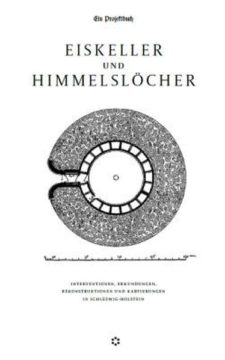The project Ice Houses and Sky Holes – Interventions, Explorations, Reconstructions and Mapping in Schleswig-Holstein 2012-13 takes the ice houses in Schleswig-Holstein, largely forgotten cultural monuments, as a base for artistic investigation and research. Within this context and in a timespan of two years between 2012 and 2013, Till Krause, Ulrike Moor, Dan Peterman, and Hans Hs Winkler developed conceptual artworks and realized them in remote locations, in damp earth cellars and on ice house mounds.
Devised with the artists, this publication shows that the concern is not so much a presentation of artworks in exotic places, but more a contribution to the current circumstances of art and society, past and present, principles of communization and climate change.
Within this framework, the artists speak a low-key and precise pictorial language. Dan Peterman shows bizarre human demeanor with a lonely ice swimmer in the endless expanse of frozen Lake Michigan. Till Krause introduces new cartographical perspectives to the ground map of Germany by setting ice paths and ice houses in relation to natural geological formations. Ulrike Mohr calls to memory a chapter from the history of natural science and Hans Hs Winkler builds a bridge between a public ice house and alternative strategies of distribution. The realization of these ice projects in historical ice houses is an attempt to access the gaps bordering on landscape, architecture, and art. As a forgotten edifice and monument of a lost sophisticated building culture, the ice house becomes a place for reflection. Far from city-event-culture, in the countryside or in the shelter of the manor estates of rural Schleswig-Holstein, the viewer is exposed to unfamiliar conditions of perception. Already the location makes the theme of climate change omnipresent; the ice house is a historical climate thermometer that delivers metadata on the climate fluctuations escorting late 19th century industrial history (Lu¨tgert 2000, p. 88-92).
Antecedents: In the 1960s, ice was discovered as a material for art by artists and art groups such as Joseph Beuys, Dennis Oppenheim, Allan Kaprow, Paul Kos and Terry Fox. Since then, the avant-gardes have re-used ice in manifold material investigations as an ambivalent working material that records time without calling on characteristics of stable substance and determined form. The interview with Harald Kimpel invites us to re-read these projects and must be understood as a dialog between the historical projects and the Ice House-Project. In These contextualizations the issues of “Art and climate change” in Kunstforum International (“Kunst und Klimawandel”), vol. 199, 2009 and the general discourse on aesthetics and sustainablity got an increasing relevance. The ice house project has unraveled these and many other own thoughts of the artists anew, to a certain extent in ideal locations, in the span between natural and cultural landscapes and art as a temporary intervention and installation.
A rediscovery of the ice house together with local inhabitants stirs old tales and its presentation within the focus of contemporary art triggers new fantasies, lifting this preindustrial testimony of a forgotten technological culture to a treasured value. Beauty and aesthetics of the ice houses as qualities beyond a sheer utilitarian role were repeatedly subject of discussion. At all times, the manifold imaginative architectural features and technical ingenuity of this heritage monument have exerted great fascination. The archival documents collected in this book direct our attention towards a cultural field that, in Addition to cultural historiography and scholarship, is coined by tales. These have added to the inspiration of the artworks and will remain with them.
A number of themes could only be touched on and call for further development.
The thought of a custom built communal ice house was a permanent companion to the project. This must also be understood within the context of the Project sequel chosen by Hans Hs Winkler. The historical building plan calls for the conceptual construction of a communal ice house of the 21st century. The publication is not only a documentation of the project, but also a collection of materials and source for further discussion and projects. It is also a book on exploration and on the ambivalent beauty of ice.
The project was financially supported by Stiftung Kunstfonds zur Förderung der bildenden Kunst in Bonn, the Kulturstiftung des Landes Schleswig-Holstein, the Muthesius Kunsthochschule in Kiel, and MUK Logistik GmbH in Munich.
The incentive for the general idea of the project came from Stephan A. Lu¨tgert’s publication “Eiskeller, Eiswerke und Ku¨hlhaeuser in Schleswig-Holstein und Hamburg” (“Ice Houses, Ice Plants and Cold Stores in Schleswig-Holstein and Hamburg”, Husum 2000).
We wish to thank all who stimulated us, above all the owners of the ice houses for their pro-active support. Next to works by Till Krause, Ulrike Mohr, Dan Peterman, and Hans Hs Winkler, the Kunstverein Haus 8 in Kiel also presented photographic contributions and videos on the topic of ice by Paul Kos, Jill Taffet, and Lisa K. Blatt. We are most grateful to the artists for enabling us to Show their works.
Verena Voigt M.A. and Hans Hs Winkler, Project Initiators
- Veröffentlicht am Sonntag 15. Dezember 2024 von Revolver Publishing
- ISBN: 9783957630261
- 190 Seiten
- Genre: Hardcover, Kunst, Softcover
